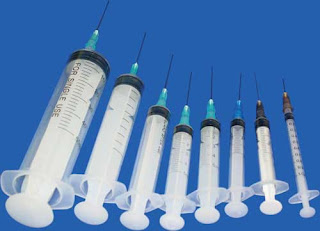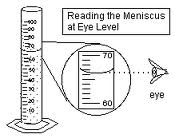The volume of an object is the amount of space it takes up. You will often measure the volume of liquids using a graduated cylinder. (“Graduated” means that the cylinder is marked with measurement units.) Always read a graduated cylinder at eye level. Also, water in a graduated cylinder has a curved surface called the meniscus. Read the volume at the bottom of the meniscus.
Tuesday, October 19, 2010
Monday, October 18, 2010
Activity 1: Measuring Volume ; How Much Liquid Can it Hold?
How much tea can actually fit in a tea cup? To find out you will need a measuring cup and some household objects. This worksheet is all about determining the volume of an object. To complete this activity you will need to look at the objects pictured, estimate how much liquid they can hold, and then measure the volume and write the findings on the page. How close were your estimates? This worksheet will support the important scientific principle of making a hypothesis and then testing it through experimentation.
 |
| Picture : Activity 1 |
How you can measure the volume of liquids
Liquid volumes can be measured in various ways using special apparatus or equipment.
1. The measuring (or graduated) cylinder .
This is for measuring out approximate volumes of liquids. It is graduated in cubic centimeters or milliliters. It comes in various sizes ;5ml, 10ml, 50ml, 100ml, 250ml, 1000ml and 2000ml.
Caution! For all liquids, except mercury, the correct reading is taken at the bottom of the curved liquid surface. For mercury the correct reading is taken at the top.
2. The burette.
This is a glass vessel that delivers small volumes of liquid up to usually, 50 cm3. For greater accuracy, it is long and thin and graduated in milliliters. Readings are always taken at the level of the bottom of the meniscus.
3. A Pipette
A pipette is used to transfer a measured volume of liquid from one container to another.
4. A Syringe.
It is similar to pipette, but is used to inject a known volume, such as 5ml, of a particular liquid medication.
5. Volumetric Flask.
It holds a fixed volume of liquid when filled up to the mark on the neck.Each of the above pieces of measuring apparatus comes in different sizes.
1. The measuring (or graduated) cylinder .
This is for measuring out approximate volumes of liquids. It is graduated in cubic centimeters or milliliters. It comes in various sizes ;5ml, 10ml, 50ml, 100ml, 250ml, 1000ml and 2000ml.
 |
| Picture : Measuring (Graduated) Cylinder. |
Caution! For all liquids, except mercury, the correct reading is taken at the bottom of the curved liquid surface. For mercury the correct reading is taken at the top.
2. The burette.
This is a glass vessel that delivers small volumes of liquid up to usually, 50 cm3. For greater accuracy, it is long and thin and graduated in milliliters. Readings are always taken at the level of the bottom of the meniscus.
 |
| Picture : Burette |
3. A Pipette
A pipette is used to transfer a measured volume of liquid from one container to another.
 |
| Picture : Pipette |
It is similar to pipette, but is used to inject a known volume, such as 5ml, of a particular liquid medication.
 |
| Picture : Many types of syringes |
5. Volumetric Flask.
It holds a fixed volume of liquid when filled up to the mark on the neck.Each of the above pieces of measuring apparatus comes in different sizes.
 |
| Picture : Different size of volumetric flask |
Subscribe to:
Comments (Atom)

